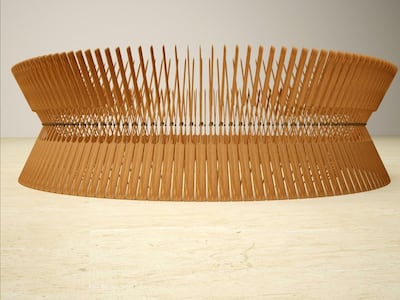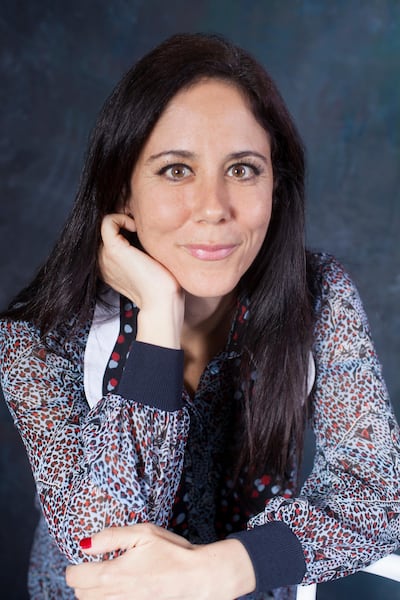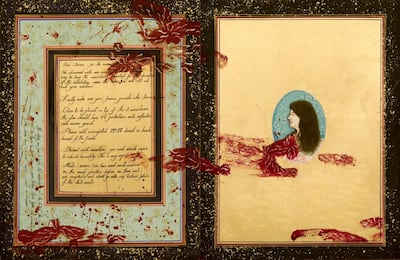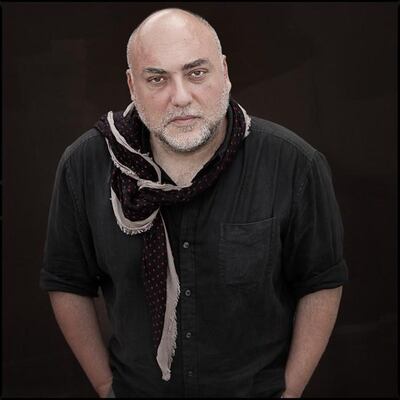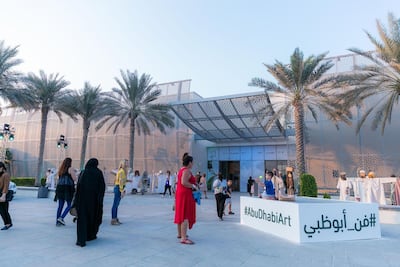A circle of wooden paddles, 10 metres in diametre, stands in Al Ain's historic Al Jahili Fort. Inspired by mankind's constant state of motion for the purpose of survival, the installation by Egyptian artist Moataz Nasr is called Sun Boats, and is based on the Ancient Egyptian belief that humans would depart this life to the eternal one using sun boats with large paddles.
The piece is also a reference to the 21st century migration crisis, which has mostly played out in the waters of the Mediterranean.
It is just one of the interactive elements of this year’s Abu Dhabi Art, and evidence that even if you don’t make it to the gallery halls in Manarat Al Saadiyat, it is still possible to experience the overall effect of the art across the emirate.
Under new leadership
Abu Dhabi Art has undergone quite considerable change since Dyala Nusseibeh took over the reins in 2016. While maintaining its small, almost boutique size, the fair’s additional elements, such as the not-for-profit exhibitions and the public programming, have grown exponentially, providing what Nusseibeh describes as “cultural entertainment”.
She has maintained the quality of existing sections of the fair such as Durub Al Tawaya, which concentrates on performing art, and Gateway, a curated exhibition, which includes artworks that investigate architecture as structures for meaning.
But additionally, the director has put a heavy emphasis on commissioning new work. Nasr's piece is one of three commissions in Al Ain under a section called Beyond. Pakistani artist Imran Qureshi has built a large-scale installation within the oasis, and Emirati photographer and artist Ammar Al Attar has explored Qasr Al Muwaiji, the former home of the Al Nahyan royal family.
Participating artists and galleries
Emirati artist Mohammed Ahmed Ibrahim is curator of Beyond: Emerging Artists and mentor to Ahmed Saeed Al Areef Al Dhaheri, Taqwa Al Naqbi and Dhabiya Al Romaithi, the three up-and-coming talents from the UAE taking part in this programme, producing commissions to be displayed within the fair. Al Dhaheri has created an animated video of a fictional character, Al Naqbi has delved into paper-making to explore her own family heritage and Al Romaithi's land-based art will be presented as a series of photographs. All works in this section will stay on display for two months after the fair closes.
Abu Dhabi Art is now in its 10th year and the range of works shown through participating galleries is both regionally relevant and of international quality. Of the 43 spaces in attendance, Los Angeles gallery Kayne Griffin Corcoran, will be making its Middle Eastern debut with a stunning solo show by American artist James Turrell. Sprueth Magers, which has spaces in LA, Berlin and London, will present abstract photographs by German artist Thomas Ruff, as well as a special installation by the American artist Jenny Holzer – whose permanent sculpture stands in the grounds of Louvre Abu Dhabi.
These galleries are part of the Focus section, which is curated by Omar Kholeif and subtitled Icons. "With Icons, I wanted to consider the key voices that have not only shaped and influenced contemporary art over the past five decades, but also those individuals who are setting precedents, and paving the way for future generations of artists through their diverse sets of practices," says Kholeif.
Also part of this section is Cairo's Gypsum gallery, which Kholeif invited to exhibit a solo presentation by Egyptian artist Ahmed Morsi, who lives in New York. This is the first time the gallery will be attending Abu Dhabi Art. Its founder, Aleya Hamza, says she was drawn by the fair's "openness" and lack of categorisation between contemporary and older works. "Morsi's singular vision and creative output in art, poetry and criticism attest to his distinctive position as an icon in the region," Hamza says. His practice dates back to the 1940s, and Hamza says she found it refreshing to be able to place works side by side without worrying about classifications.
Another newcomer to this year’s event is Ramallah’s Zawyeh Gallery. “Abu Dhabi Art is one of the most promising art fairs in the region and we think we have opportunities to promote and sell Palestinian art,” says Ziad Anani, the gallery’s founder. “Also, there is a good number of museums and collectors in Abu Dhabi.
Opportunities for networking and possible future projets
Zawyeh will be showing pieces by the Ziad Anani’s father, prominent artist Nabil Anani, as well as Sliman Mansour, one of the most distinguished Palestinian artists working today. Anani also says that part of the pull towards Abu Dhabi Art is the number of guest curators. “It is fantastic. We are already in touch with many curators who are coming to this fair and it presents a great opportunity to network and connect about possible future projects.”
Nusseibeh says this is part of a wider responsibility that she feels for the galleries, artists and curators who participate, as well as the audience in attendance. “In recent years, global art fairs play a more institutional role in terms of supporting artists, and it is also necessary to create an attractive programme of content for visitors. Equally, we need to think about how to maximise our engagement with the galleries so that when they come to our city, they think about our communities.
Abu Dhabi Art is specifically organised by the government so our mandate has to also be towards contributing to the art ecosystem in the UAE. The key is balancing all of these parts to deliver a successful event."
Abu Dhabi Art runs from November 14 – 17 at Manarat Al Saadiyat, Abu Dhabi

